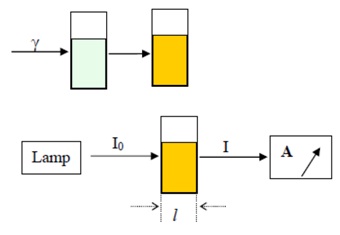Assignment
1. Calculate the dose rate and the absorbed dose for the Fricke dosimetric solution that was irradiated with Co-60 source during 3 hrs. The absorbance of the irradiated dosimetric solution (Fe3+), measured with UV/Vis-spectrophotometer in 1 cm cuvettes at the wavelength l=304 nm, increased from 0.01 (initial) to 0.203 (irradiated). The molar absorptivity of ferric ions for this wavelength is ε304 = 2187 Lmol-1cm-1, the density of the dosimetric solution is ρ=1.024 g/mL, and the tabulated radiation chemical yield for gamma source 60Co is 1.6 µmol J-1.
A = εcl
2. Calculate the dose rate and the absorbed dose for the ceric sulfate dosimetric solution that was irradiated with Co-60 source during 3 hrs. The absorbance of the irradiated dosimetric solution (Ce4+), measured with UV/Vis-spectrophotometer in 1 cm cuvettes at the wavelength l=320 nm, decreased from 1.01 (initial) to 0.21 (irradiated). The molar absorptivity of ceric ions for this wavelength is ε320 = 561 Lmol-1cm-1, density of the dosimetric solution is ρ=1.025 g/mL and the G value for the cerous-ion yield is 2.3 molecules/100 eV for the gamma source 60Co.
3. Estimate the effect of alpha-autoradiolysis in the acidic aqueous solution of 239Pu with concentration of 0.03 mol/L of 239Pu:
a) Considering the half-life T1/2=24111 y (=7.60364x1011 sec) and the alpha energy of 5.24 MeV, what is the weekly dose absorbed in 1L solution? E(alpha/Pu) = 5.24 MeV x 1.602.10-19 J/eV = 8.395x10-13 J
b) The plutonium is originally in its hexavalent state, but is reduced to its tetravalent state (then precipitated) by the reaction with hydrogen radicals. If the radiation yield of hydrogen radicals is 0.2 umol/J, how much Pu(VI) is reduced in one week? Hint: [Pu6+ + 2H* =Pu4+ +2H+]
4. The count rates listed in the table below were measured for a mixture of two genetically independent radionuclides. Both radionuclides are beta- emitters, and they both precipitate in the solution of AgNO3. Identify the unknown radionuclides in the measured mixture, and calculate their initial activity (DE = 40%). Recall that precipitating of both the unknown radionuclides with silver nitrate indicates that both unknown elements are halogens.
|
t(h)
|
0
|
0.5
|
1
|
1.5
|
2
|
3
|
4
|
5
|
6
|
7
|
8
|
10
|
12
|
|
c/m
|
6000
|
3043
|
1698
|
1062
|
741
|
455
|
321
|
237
|
177
|
132
|
99
|
56
|
31
|
HINT:
The concentrations of colored solution are usually determined spectrophotometrically. Method is based on the Lambert-Beer law, which binds the absorbance A(decrease of the light beam intensity) with the molar concentration of the analyte C, its molar absorptivity ε(constant at given wavelength)and the length of the light path (thickness of the cuvette with measured liquid):
A = ε.c.l

Format your assignment according to the following formatting requirements:
1. The answer should be typed, double spaced, using Times New Roman font (size 12), with one-inch margins on all sides.
2. The response also include a cover page containing the title of the assignment, the student's name, the course title, and the date. The cover page is not included in the required page length.
3. Also Include a reference page. The Citations and references should follow APA format. The reference page is not included in the required page length.